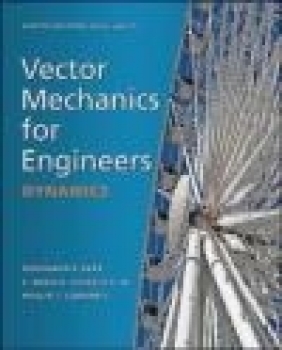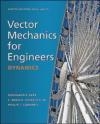Vector Mechanics for Engineers 9e
Phillip J. Cornwell, E. Russell Johnston, Ferdinand P. Beer
Vector Mechanics for Engineers 9e
Phillip J. Cornwell, E. Russell Johnston, Ferdinand P. Beer
- Producent: McGraw-Hill
- Rok produkcji: 2010
- ISBN: 9780071311083
- Ilość stron: 784
- Oprawa: Miękka
Niedostępna
Opis: Vector Mechanics for Engineers 9e - Phillip J. Cornwell, E. Russell Johnston, Ferdinand P. Beer
Vector Mechanics for Engineers: Dynamics provides conceptually accurate and thorough coverage, and its problem-solving methodology gives students the best opportunity to learn dynamics. This new edition features a significantly refreshed problem set. Key Features Chapter openers with real-life examples and outlines previewing objectives Careful, step-by-step presentation of lessons Sample problems with the solution laid out in a single page, allowing students to easily see important key problem types Solving Problems on Your Own boxes that prepare students for the problem sets Forty percent of the problems updated from the previous editionPreface Acknowledgments List of Symbols Chapter 11 Kinematics of Particles 11.1 Introduction to Dynamics Rectilinear Motion of Particles 11.2 Position, Velocity, and Acceleration 11.3 Determination of the Motion of a Particle 11.4 Uniform Rectilinear Motion 11.5 Uniformly Accelerated Rectilinear Motion 11.6 Motion of Several Particles *11.7 Graphical Solution of Rectilinear-Motion Problems *11.8 Other Graphical Methods Curvilinear Motion of Particles 11.9 Position Vector, Velocity, and Acceleration 11.10 Derivatives of Vector Functions 11.11 Rectangular Components of Velocity and Acceleration 11.12 Motion Relative to a Frame in Translation 11.13 Tangential and Normal Components 11.14 Radial and Transverse Components Review and Summary Review Problems Computer Problems Chapter 12 Kinetics of Particles: Newton's Second Law 12.1 Introduction 12.2 Newton's Second Law of Motion 12.3 Linear Momentum of a Particle. Rate of Change of Linear Momentum 12.4 Systems of Units 12.5 Equations of Motion 12.6 Dynamic Equilibrium 12.7 Angular Momentum of a Particle. Rate of Change of Angular Momentum 12.8 Equations of Motion in Terms of Radial and Transverse Components 12.9 Motion under a Central Force. Conservation of Angular Momentum 12.10 Newton's Law of Gravitation *12.11 Trajectory of a Particle under a Central Force *12.12 Application to Space Mechanics *12.13 Kepler's Laws of Planetary Motion Review and Summary Review Problems Computer Problems Chapter 13 Kinetics of Particles: Energy and Momentum Methods 13.1 Introduction 13.2 Work of a Force 13.3 Kinetic Energy of a Particle. Principle of Work and Energy 13.4 Applications of the Principle of Work and Energy 13.5 Power and Efficiency 13.6 Potential Energy *13.7 Conservative Forces 13.8 Conservation of Energy 13.9 Motion under a Conservative Central Force. Application to Space Mechanics 13.10 Principle of Impulse and Momentum 806 13.11 Impulsive Motion 13.12 Impact 13.13 Direct Central Impact 13.14 Oblique Central Impact 13.15 Problems Involving Energy and Momentum Review and Summary Review Problems Computer Problems 852 Chapter 14 Systems of Particles 14.1 Introduction 14.2 Application of Newton's Laws to the Motion of a System of Particles. Effective Forces 14.3 Linear and Angular Momentum of a System of Particles 14.4 Motion of the Mass Center of a System of Particles 14.5 Angular Momentum of a System of Particles about Its Mass Center 14.6 Conservation of Momentum for a System of Particles 14.7 Kinetic Energy of a System of Particles 14.8 Work-Energy Principle. Conservation of Energy for a System of Particles 14.9 Principle of Impulse and Momentum for a System of Particles *14.10 Variable Systems of Particles *14.11 Steady Stream of Particles *14.12 Systems Gaining or Losing Mass Review and Summary Review Problems Computer Problems Chapter 15 Kinematics of Rigid Bodies 15.1 Introduction 15.2 Translation 15.3 Rotation about a Fixed Axis 15.4 Equations Defining the Rotation of a Rigid Body about a Fixed Axis 15.5 General Plane Motion 15.6 Absolute and Relative Velocity in Plane Motion 15.7 Instantaneous Center of Rotation in Plane Motion 15.8 Absolute and Relative Acceleration in Plane Motion *15.9 Analysis of Plane Motion in Terms of a Parameter 15.10 Rate of Change of a Vector with Respect to a Rotating Frame 15.11 Plane Motion of a Particle Relative to a Rotating Frame. Coriolis Acceleration *15.12 Motion about a Fixed Point 984 *15.13 General Motion 987 *15.14 Three-Dimensional Motion of a Particle Relative to a Rotating Frame. Coriolis Acceleration *15.15 Frame of Reference in General Motion Review and Summary Review Problems Computer Problems Chapter 16 Plane Motion of Rigid Bodies: Forces and Accelerations 16.1 Introduction 16.2 Equations of Motion for a Rigid Body 16.3 Angular Momentum of a Rigid Body in Plane Motion 16.4 Plane Motion of a Rigid Body. D'Alembert's Principle *16.5 A Remark on the Axioms of the Mechanics of Rigid Bodies 16.6 Solution of Problems Involving the Motion of a Rigid Body 16.7 Systems of Rigid Bodies 16.8 Constrained Plane Motion Review and Summary Review Problems Computer Problems 1079 Chapter 17 Plane Motion of Rigid Bodies: Energy and Momentum Methods 17.1 Introduction 17.2 Principle of Work and Energy for a Rigid Body 17.3 Work of Forces Acting on a Rigid Body 17.4 Kinetic Energy of a Rigid Body in Plane Motion 17.5 Systems of Rigid Bodies 17.6 Conservation of Energy 17.7 Power 17.8 Principle of Impulse and Momentum for the Plane Motion of a Rigid Body 17.9 Systems of Rigid Bodies 17.10 Conservation of Angular Momentum 17.11 Impulsive Motion 17.12 Eccentric Impact Review and Summary Review Problems Computer Problems Chapter 18 Kinetics of Rigid Bodies in Three Dimensions *18.1 Introduction *18.2 Angular Momentum of a Rigid Body in Three Dimensions *18.3 Application of the Principle of Impulse and Momentum to the Three-Dimensional Motion of a Rigid Body *18.4 Kinetic Energy of a Rigid Body in Three Dimensions *18.5 Motion of a Rigid Body in Three Dimensions *18.6 Euler's Equations of Motion. Extension of D'Alembert's Principle to the Motion of a Rigid Body in Three Dimensions *18.7 Motion of a Rigid Body about a Fixed Point *18.8 Rotation of a Rigid Body about a Fixed Axis *18.9 Motion of a Gyroscope. Eulerian Angles *18.10 Steady Precession of a Gyroscope *18.11 Motion of an Axisymmetrical Body under No Force Review and Summary Review Problems Computer Problems Chapter 19 Mechanical Vibrations 19.1 Introduction Vibrations without Damping 19.2 Free Vibrations of Particles. Simple Harmonic Motion 19.3 Simple Pendulum (Approximate Solution) *19.4 Simple Pendulum (Exact Solution) 19.5 Free Vibrations of Rigid Bodies 19.6 Application of the Principle of Conservation of Energy 19.7 Forced Vibrations Damped Vibrations *19.8 Damped Free Vibrations *19.9 Damped Forced Vibrations *19.10 Electrical Analogues Review and Summary Review Problems Computer Problems Appendix A Some Useful Definitions and Properties of Vector Algebra Appendix B Moments of Inertia of Masses Appendix C Fundamentals of Engineering Examination Photo Credits Index Answers to Problems
Szczegóły: Vector Mechanics for Engineers 9e - Phillip J. Cornwell, E. Russell Johnston, Ferdinand P. Beer
Tytuł: Vector Mechanics for Engineers 9e
Autor: Phillip J. Cornwell, E. Russell Johnston, Ferdinand P. Beer
Producent: McGraw-Hill
ISBN: 9780071311083
Rok produkcji: 2010
Ilość stron: 784
Oprawa: Miękka
Waga: 1.35 kg






























